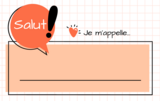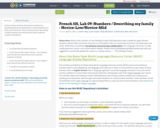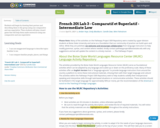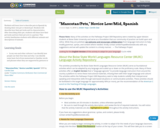
Descriptions
The Family
- Subject:
- Arts and Humanities
- Languages
- Material Type:
- Lesson
- Date Added:
- 09/20/2018

Descriptions
The Family

Students will practice introducing each other. Students will also gain experience with describing clothes and colors.

Students will identify themselves using characteristics in French. Students will ask a partner questions about themselves to identify what the person is like. Students will then describe their partner to others.

Students will identify themselves using characteristics in French. Students will ask a partner questions about themselves to identify what the person is like. Students will then describe their partner to others.

In this activity, students will practice describing locations on a city map. Students will also explain their telephone numbers and practice talking about cities and their family.

In this activity, students will practice their pronunciation and describe articles of clothing.

In this activity, students will practice their pronunciation and describe articles of clothing.

In this activity, students will practice superlatives and comparatives by drawing in partners and playing a board game.

In this activity, students will practice how to say they have to do something as well as how to say they want to do something.

First, students will view a slide with works from German artists. They are going to describe the art with old and new adjectives. There is a clue about art in the warm-up word slide, Deutsche Adjektive. (it is written in the colors of the rainbow and then the three primary colors). Then students put these new and old adjectives to use as they digitally search museums in Berlin, hunting for art that depicts certain adjectives. Finally, in the end students share about other types of German art they enjoy - music, architecture, design, etc.

In this activity, students will practice describing themselves and their peers by playing a game of Guess Who.

Students learn new German vocabulary to describe themselves and their family members

This article provides links to inquiry-based, hands-on science lessons that teach elementary students about rocks and minerals. Literacy lessons and integrations are included for each science lesson.

This lab explains the importance of facial expressions to students. They will get to play a fun game that will also help them work on asking questions and giving descriptions.

In this lab, students will use a word bank on the whiteboard to describe people, places, and things in the presentation slides. Students will first be asked to provide adjectives for color, positive adjectives, and negative adjectives. Students will then flip two coins to determine the sentence they will construct.NCSSFL-ACTFL Can-Do Statements:I can use simple descriptions to describe people, places, and things.I can say whether an object is fast or slow, clean or dirty, etc.I can say whether an object is NOT fast or slow, clean or dirty, etc.

In this lab, students will practice connecting sentences with te-form by describing a handful of pictures. Pairs of students will then conduct a mock tour, with one student acting as a tour guide and the other acting like a famous historical figure. Once the tour guide has learned enough about the “famous person,” the students will then schedule a tour together, keeping in mind the information gathered from the interview. NCSSFL-ACTFL Can-Do Statements:I can schedule a day’s worth of activities for another person.I can ask about someone’s preferences, including their likes and dislikes.

Students will learn how to describe pets in Spanish by drawing their own pet or desired pet. Students will describe how their pet looks and its characteristics. After describing their pet, students will share how their pet looks and how their pet acts to a partner. This activity familiarizes students with different animals and descriptions of animals.

Students will learn how to describe clothing using color and descriptive vocabularies. They will also learn about various types of accessories and items.

Students will practice using descriptive language via a Head’s Up game. Each student will then assume the role of a popular Halloween character and push their ability to question and answer by playing 20 questions.